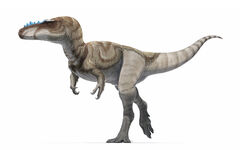
| Alioramus Temporal range: 70–Late Cretaceous Ma | |
|---|---|

| |
| An artist's interpretation of Alioramus | |
| Scientific classification | |
| Kingdom: | Animalia |
| Phylum: | Chordata |
| Class: | Sauropsida |
| clade: | Dinosauria |
| Superorder: | Theropoda |
| Superfamily: | †Tyrannosauroidea |
| Family: | †Tyrannosauridae |
| Subfamily: | †Tyrannosaurinae |
| Tribe: | †Alioramini |
| Genus: | †Alioramus Kurzanov, 1976 |
| Type species | |
| †Alioramus remotus Kurzanov, 1976 | |
| Referred species | |
| |
| Synonyms | |
| |
Alioramus (meaning different branch) is a genus of tyrannosaurid theropod dinosaur from the Late Cretaceous period of Mongolia. The type species, known as A. remotus, is only known from an incomplete skull and three metatarsal bones from the Nemegt Formation,Mongolia. These remains have been estimated to be around 70 million years old. It was described by Soviet paleontologist Sergei Kurzanov in 1976. In 2009, a second species of Alioramus, known as A. altai, was and described in 2009 by Stephen L. Brusatte and his colleagues. This species is known from a far more complete skeleton than A.remotus Its relationships to other tyrannosaurids are currently unclear, but some evidence supports the theory that it is a close relative to Tarbosaurus. However, the discovery of Qianzhousaurus shows that Alioramus instead belongs to a different tribe of tyrannosaurinae, known as Alioramini.
Characteristics[]
Similar to other theropods, Alioramus was bipedal. The known specimens of the dinosaur were quite smaller than other tyrannosaurids such as Tyrannosaurus and the contemporary Tarbosaurus, although this is likely because all of its fossils represent juveniles or adolecents. The discovery of Qianzhousaurus in 2010 indicates that Alioramus would instead belong to a different branch of tyrannosaurids known as Alioramini.[2] Characteristics of Alioramus include five crests running down the snout, more teeth than any other tyrannosaurid and a lower skull than the rest of its family.
Discovery and naming[]
In popular culture[]
- Alioramus was supposed to appear in the video game Jurassic Park: Operation Genesis but was cut.
- Alioramus is shown in Dinosaur King.
- In the enhanced-motion vehicle attraction Countdown to Extinct AKA Dinosaur at Disney's Animal Kingdom theme park, an Alioramus is announced by an on-board computer, and is seen digging in the ground. As the vehicle nears the rooting dinosaur, it raises up to reveal a small alligatoroid named Brachychampsa in its mouth, which it proceeds to swallow as the prey kicks it hind legs and lashes with its tail to no avail. Both creatures are brought to life through Audio-Animatronics. It also is featured in the gift shop with toys inspired by the animatronic.
- Alioramus was mentioned on Dinosaur Train.
Gallery[]
References[]
To be added with unplagiarized content
External links[]
- Alioramus remotus at DinoData.org
- Alioramus remotus at The Theropod Database
- Skull image of Alioramus at The Grave Yard
- Illustration showing the pieces found of Alioramus altai.
- ↑ (2017) "A new tyrannosaur with evidence for anagenesis and crocodile-like facial sensory system". Scientific Reports 7: 44942. DOI:10.1038/srep44942.
- ↑ Junchang Lü (7 May 2014). "A new clade of Asian Late Cretaceous long-snouted tyrannosaurids". Nature Communications 5 (3788). DOI:10.1038/ncomms4788.







